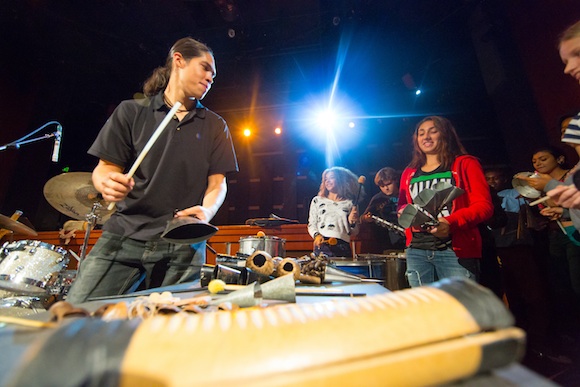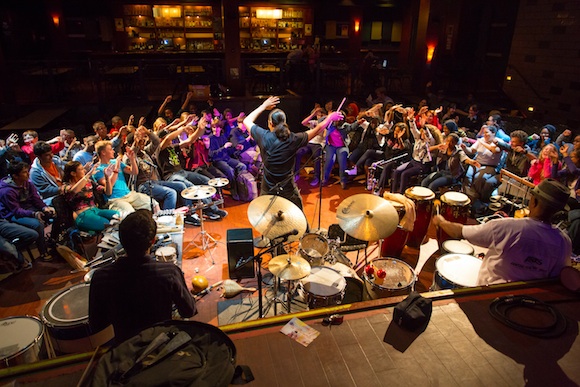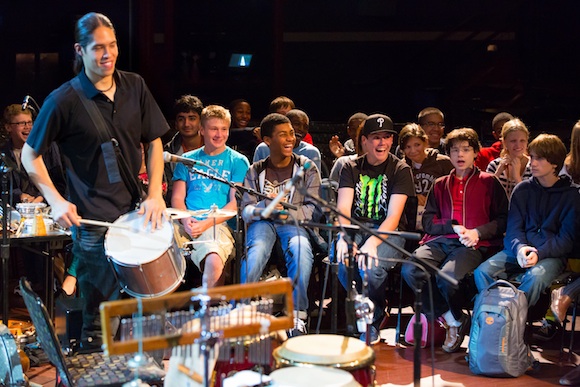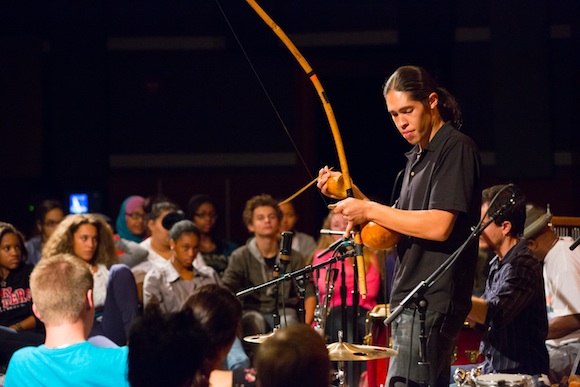Live Connections' Bridge Sessions at World Cafe Live remind board member Alex Shaw of Iron Chef. On the popular TV show, world class cooks have an hour to make a sumptuous meal out of surprise ingredients. According to Shaw, that's a pretty good metaphor for the synthesis of diverse musical elements that has happened in five years of Bridge Sessions.
These interactive performances feature live music from teaching artists, and participants also have the chance to create music through interactive activities. This integrated method helps attendees understand how different musical styles relate, how the building blocks of music inform the final product and how music connects people across cultures and backgrounds. The new season of Bridge Sessions begins October 21.
Shaw, a Virginia native and Swarthmore graduate, specializes in Brazilian percussion. He has been involved with Live Connections since the idea for its multicultural music access programs was hatched at a World Cafe Live roundtable several years ago.
These days, Live Connections, in partnership with World Cafe Live, provides a venue for all sorts of educational music programming for free or at very low cost — they have reached over 14,000 people since inception. Most of their work is geared towards urban youth who may not otherwise have access to music in struggling Philadelphia schools, and people with physical or intellectual disabilities who are often left out of the city's cultural scene.
Co-founder David Bradley, who curates the Bridge Sessions, says they aren't about dictating a curriculum to the artists.
“It's the idea of artists coming from different cultures, different genres, [and] creating programs,” he explains. The sessions put groups of artists from different genres together to “create something that is about this idea of a bridge. How does music bridge different cultures, how does music bridge different styles and genres?”
Shaw's Brazilian drums might be paired with a classical cello or violin from the Philadelphia Orchestra: “How do you create full repertoire that has a sense of cohesion and a sense of direction, dealing with odd pairings and odd matchings?” asks Shaw.
Letting attendees watch and participate in the often improvisational discovery offers an experience beyond the universal language of music.
“A common question [we get] is how long the Bridge artists have played together,” says Bradley. Sometimes, the answer is that it's first time those musicians have ever collaborated. “But we have this language we know, which is music, that's a vocabulary, and that allows us to connect. And that's important for kids to hear.”
The underlying message is that it's OK to experiment and connect with others who are different from you.
“We're all working out of our comfort zones,” says Shaw. For example, in a recent Bridge Session, a principal orchestra cellist with unparalleled technical skills got nervous when asked to improvise. “It really produces some amazing programming when you have artists that are competent and willing to take risks.”
Live Connections celebrated its fifth anniversary this month, having served 80 different schools and organizations with the participation of over 70 artists, from classical musicians to national spoken-word luminaries like Denice Frohman, the 2013 winner of the Women of the World Poetry Slam. (“She's dynamite at getting kids to write,” says Bradley.)
Shaw and Bradley emphasize that the Bridge Sessions aren't concerts, and they aren't music classes, either. To begin with, the musicians or artists don't keep to the stage — they sit right on the ground with the audience.
“That's about access and intimacy,” says Bradley says, touting the up-close “tactile, tangible experience.” When a professional cellist plays five feet away from a fourth-grader, “you see her mastery; you see how good she is…the phrase 'making music' comes alive because you really are watching music get made.”
Shaw describes an “aural journey” exercise that encourages kids to imagine the scenery different instruments can evoke. “It's almost as if you're waving different kinds of food or spices in front of somebody's nose, and [asking], where do you imagine you are?”
The Bridge Sessions also emphasize how the universal vocabulary of music and rhythm reflects the fundamentals of any field. Appreciating the basics of music helps youngsters understand that other artistic or academic subjects have building blocks that anyone can master.
This year, 15 sessions will feature Shaw, Frohman, cellist Udi Bar-David, percussionists Doc Gibbs and Hafez El Ali Kotain, Harold Robinson on the double bass, movement artist Lela Aisha Jones and many more.
Bradley touts the vital role of music education as the arts and field trips are stripped from the school district's straining budget.
“Art in general, music specifically, is an invitation to imagine,” he says. “It's also an essential point of learning, particularly in a world where connecting globally is more important, and polarization is one of our larger social problems.”
In short, when we have access to music, “we feel things. It wakes us up.”
For more information on joining in, or to view the full schedule of this year's Bridge Sessions, visit the Live Connections website.
ALAINA MABASO, a Philadelphia-based freelance journalist, has landed squarely in what people tell her is the worst possible career of the twenty-first century. So she makes Pennsylvania her classroom, covering everything from business to theater to toad migrations. After her editors go to bed, she blogs at http://alainamabaso.wordpress.com/. Find her on Twitter @AlainaMabaso.




